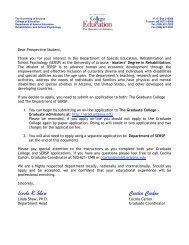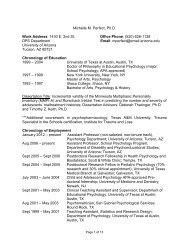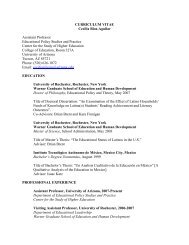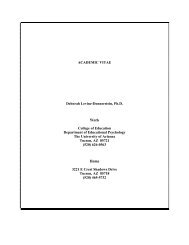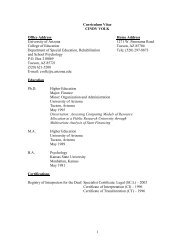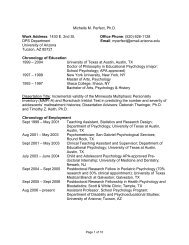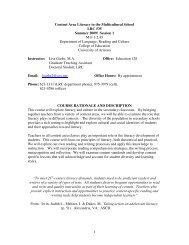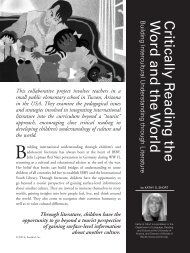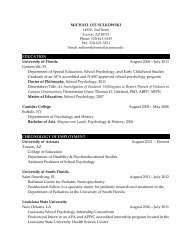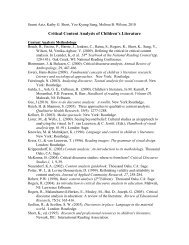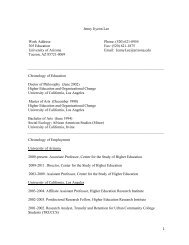Our Reflections on Writing for Publication
Our Reflections on Writing for Publication
Our Reflections on Writing for Publication
Create successful ePaper yourself
Turn your PDF publications into a flip-book with our unique Google optimized e-Paper software.
538<strong>Writing</strong> <strong>for</strong> Language Artssi<strong>on</strong> of her self-study as a teacher.Edelsky (2004) uses references outsideof educati<strong>on</strong> from political scienceto develop her discussi<strong>on</strong> ofdemocracy.Establish the Classroomand Curricular C<strong>on</strong>textReaders need to have some sense ofthe school and classroom c<strong>on</strong>textbe<strong>for</strong>e moving into a reflectiveanalysis of the examples from thatsetting. The major goal is to providethe reader with enough descripti<strong>on</strong>of the c<strong>on</strong>text and curricularengagements to adequately understandthe examples without takingover the space needed to expand <strong>on</strong>those examples. The c<strong>on</strong>text comesbe<strong>for</strong>e the main body of the article,so an unnecessarily detaileddescripti<strong>on</strong> of the c<strong>on</strong>text delaysthe reader’s grasp of the actualfocus. Keep in mind that the writerhas lived in that c<strong>on</strong>text <strong>for</strong> a l<strong>on</strong>gtime, so must carefully select thein<strong>for</strong>mati<strong>on</strong> essential to clarifyingthe specific points of the article.The c<strong>on</strong>text can be short, as inGoodman (2005) where in <strong>on</strong>e paragraph,she quickly establishes theschool c<strong>on</strong>text, describes her role inthe school, and introduces the children.She puts more focus <strong>on</strong> thetheoretical c<strong>on</strong>text and the beliefsthat guided her work. In c<strong>on</strong>trast,Rowe, Fitch, and Bass (2003)provide a lengthy descripti<strong>on</strong> of theengagement of Toy Stories and howit emerged over time be<strong>for</strong>e goinginto an analysis of the data fromthat engagement. They brieflydescribe the school and writersworkshop, since this classroomstructure is familiar to readers, butthe Toy Stories engagement is unfamiliarand represents a key part oftheir work, so it needs more extensivediscussi<strong>on</strong>.An additi<strong>on</strong>al aspect of the c<strong>on</strong>text<strong>for</strong> studies is a descripti<strong>on</strong> of theresearch methodology. In general, weencouraged writers to keep thisdescripti<strong>on</strong> brief—a paragraph ortwo—because our readers’ mainfocus is the authors’ reflecti<strong>on</strong>sabout their findings, not a researchreport typical of a research journal.Jennings with O’Keefe (2002)indicates in <strong>on</strong>e paragraph whatdata was gathered and how it wasanalyzed because the methods arefamiliar <strong>on</strong>es. Laman (2006), in c<strong>on</strong>trast,has a whole secti<strong>on</strong> <strong>on</strong> usingcultural models <strong>for</strong> analysis, a lessfamiliar <strong>for</strong>m of analysis that framesher classroom data and discussi<strong>on</strong>.Many of our lettersasked authors toselectively choosewhich key points toinclude related to thecentral focus.Develop Key Points and Argumentsthrough Rich ExamplesThe heart of the article—and thereas<strong>on</strong> the reader has perseveredthrough the earlier secti<strong>on</strong>s—is thediscussi<strong>on</strong> of the key points relatedto the central tensi<strong>on</strong> established inthe introducti<strong>on</strong>. These pointsdevelop the arguments that theauthor wants to make in discussingand providing new insights relatedto this tensi<strong>on</strong>. A major writingdecisi<strong>on</strong> is which key points tomake within an article. Includingtoo many points leads to n<strong>on</strong>e ofthem being developed in enoughdepth; too few points can result innot revealing the complexity of theissues around the central focus.Many of our letters asked authors toselectively choose which key pointsto include related to the centralfocus and to exclude other pointsthat were interesting, but notdirectly part of that argument.Once those key points have beenselected, providing examples todevelop and support those pointsmakes the difference between an articlethat seems to be based <strong>on</strong> pers<strong>on</strong>alopini<strong>on</strong> or that asks readers to justaccept what the author is arguing andan article that comes alive and effectivelycarries the reader into the argument.We found ourselves c<strong>on</strong>tinuallyoffering these suggesti<strong>on</strong>s:• Be selective in choosing several examplesand present them in depth. Makesure they provide different perspectives<strong>on</strong> the same point, not the same view.The range of examples should dem<strong>on</strong>stratethe complexity of the issues.• Discuss each example; d<strong>on</strong>’t just presentit and move <strong>on</strong>. Since authorsknow the children and c<strong>on</strong>text in muchgreater depth than readers, readersneed the author’s interpretati<strong>on</strong> tounderstand the points. Reflecting <strong>on</strong>those interpretati<strong>on</strong>s through insightsfrom professi<strong>on</strong>al literature can deepenthat discussi<strong>on</strong>.• Menti<strong>on</strong> alternative interpretati<strong>on</strong>s.When appropriate, we asked authors t<strong>on</strong>ote other possible interpretati<strong>on</strong>s ofparticular data, instead of <strong>on</strong>ly presentingtheir perspective.• Be careful about over-interpreting thedata. Authors have str<strong>on</strong>g beliefs thatgrow out of their broader work in thefield, and it’s tempting to bring thosebeliefs into a manuscript, even whenthe data do not directly support thatbelief. Other times, authors feel thatthey need to make big claims abouttheir findings to establish their worth.Over-interpreting endangers credibility.• Keep transcripts short. While there aretimes when l<strong>on</strong>g transcript excerpts areessential, we found that readers oftenskip l<strong>on</strong>g transcripts and have difficultyknowing what to focus <strong>on</strong> within thatexcerpt. Transcripts are more effectivewhen the author uses a narrative summaryof the discussi<strong>on</strong> al<strong>on</strong>g with shortfocused excerpts.Language Arts, Vol. 83 No. 6, July 2006



